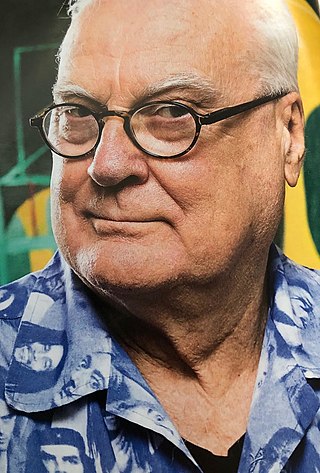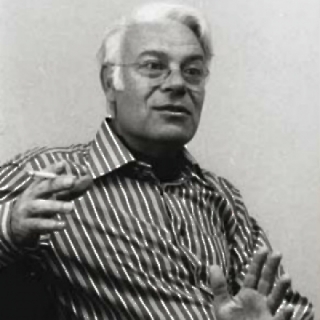
Gordon Hookey is an Australian aboriginal artist from the Waanyi people. He has a Bachelor of Fine Arts (1992) and lives in Brisbane, Australia. He is primarily known as a painter but his practice also involves sculpture, installation, drawing, photography, and to a lesser extent, animation.
Elisabeth Cummings is an Australian artist known for her large abstract paintings and printmaking. She has won numerous awards including Fleurieu Art Prize, The Portia Geach Portrait Prize, The Mosman Art Prize, and The Tattersalls Art Prize. Her work is owned in permanent collections across Australia including Artbank, The Queensland Art Gallery, The Gold Coast City Art Gallery and the Art Gallery of New South Wales. She is notable for receiving recognition later in her career, considered by the Australian Art Collector as one of the 50 most collectible Australian Artists.
Richard Bell is an Aboriginal Australian artist and political activist. He is one of the founders of proppaNOW, a Brisbane-based Aboriginal art collective.
Vivienne Joyce Binns is an Australian artist known for her contribution to the Women's Art Movement in Australia, her engagement with feminism in her artwork, and her active advocacy within community arts. She works predominantly in painting.

Grahame Edwin King was a master Australian printmaker, who has been called the "patron saint of contemporary Australian printmaking". He was responsible for the revival of print making in Australia in the 1960s. He helped set up the Print Council of Australia, of which he was the first Honorary Secretary and was later President. He taught printmaking at The Royal Melbourne Institute of Technology (RMIT) from 1966 to 1988. In 1991, he was awarded an Order of Australia for his services to education. As well as teaching, King produced his own art work, concentrating on lithographs and monotypes. He was also a skilled photographer and used his photography both in his teaching and in his practice.
Lawrence Daws is an Australian painter and printmaker, who works in the media of oil, watercolour, drawing, screenprints, etchings and monotypes.

Gareth Sansom is an Australian artist, painter, printmaker and collagist and winner of the 2008 John McCaughey Memorial Prize of $100,000.
Julie Rrap is an Australian contemporary artist who was raised on the Gold Coast in Queensland She was born Julie Parr, and reversed her name to express her sense of opposition. Since the mid-1970's she has worked in photography, painting, sculpture, video and performance. Julie's work expresses her interest in images of the body, especially the female body. She has participated in many exhibitions in Australia and abroad, won many awards, and is represented in major public and private collection in Australia and New Zealand, as well as in Belgium, Netherlands, Switzerland, Italy, France, and the U.S.A.
Robert Rooney (1937–2017) was an artist and art critic from Melbourne, Australia, and a leading figure in Australian Conceptual art.
Geoffrey Ricardo is an Australian contemporary visual artist whose work focuses on his sculpture and printmaking practice.
Alun Leach-Jones, was a British-born Australian artist known for his range of work covering painting, drawing, sculpture, linocuts, screenprints and etchings.

Udo Sellbach (1927–2006) was a German-Australian visual artist and educator whose work focused primarily around his printmaking practice.

Judy Watson is an Australian Waanyi multi-media artist who works in print-making, painting, video and installation. Her work often examines Indigenous Australian histories, and she has received a number of high profile commissions for public spaces.
Jennifer Watson is an Australian artist known for her paintings that combine text and images.
Lesley Dumbrell, born on 14 October 1941 in Melbourne, is an Australian artist known for her precise abstract geometric paintings, and was a pioneer of the Australian Women's Art Movement of the 1970s. She became known as 'one of the leading artists in Melbourne to adopt the international styles of colour field and hard-edged abstraction'.
Gemma Smith is an Australian painter and sculptor, who is Sydney-based. Smith has been the recipient of numerous grants and been invited to join multiple exhibitions. She is known for her continuous experimentations with colour and abstraction. Her work is held in museum, corporate and private collections across Australia.
Maria Josette Orsto was an aboriginal artist born at Pirlangimpi, on Melville Island. Her father, Declan Apuatimi, and her mother, Jean Baptiste Apuatimi, were also noted aboriginal artists from the Tiwi Islands. Orsto was one of the first female members of Tiwi Designs. Prior to her death she worked and lived at Wurrumiyanga on Bathurst Island.

The Field, held August 21–September 28, 1968, was the inaugural exhibition at the National Gallery of Victoria’s new premises on St Kilda Road, launched by the director of London’s Tate gallery, Norman Reid, before an audience of 1000 invitees. Hailed then, and regarded since as a landmark exhibition in Australian art history, it presented the first comprehensive display of colour field painting and abstract sculpture in the country in a radical presentation, between silver foil–covered walls and under geometric light fittings, of 74 works by 40 artists. All practised hard-edge, geometric, colour and flat abstraction, often in novel media including coloured or transparent plastic, fluorescent acrylic paints, steel and chrome. The art was appropriate to a launch of the new venue itself, designed by architect Roy Grounds, and emphatically rectilinear; cubes nested in a basalt rectangular box amongst the other buildings of the new Arts Centre, each based on a geometric solid. Echoing emerging international stylistic tendencies of the time, The Field sparked immediate controversy and launched the careers of a new generation of Australian artists.
Hertha Kluge-Pott is a German-born Australian printmaker based in Melbourne.

Barbara Nancy Brash was a twentieth-century post-war Australian artist known for her painting and innovative printmaking. In an extensive career she contributed to the Melbourne Modernist art scene, beside other significant women artists including: Mary Macqueen, Dorothy Braund, Anne Marie Graham, Constance Stokes, Anne Montgomery (artist) and Nancy Grant.






